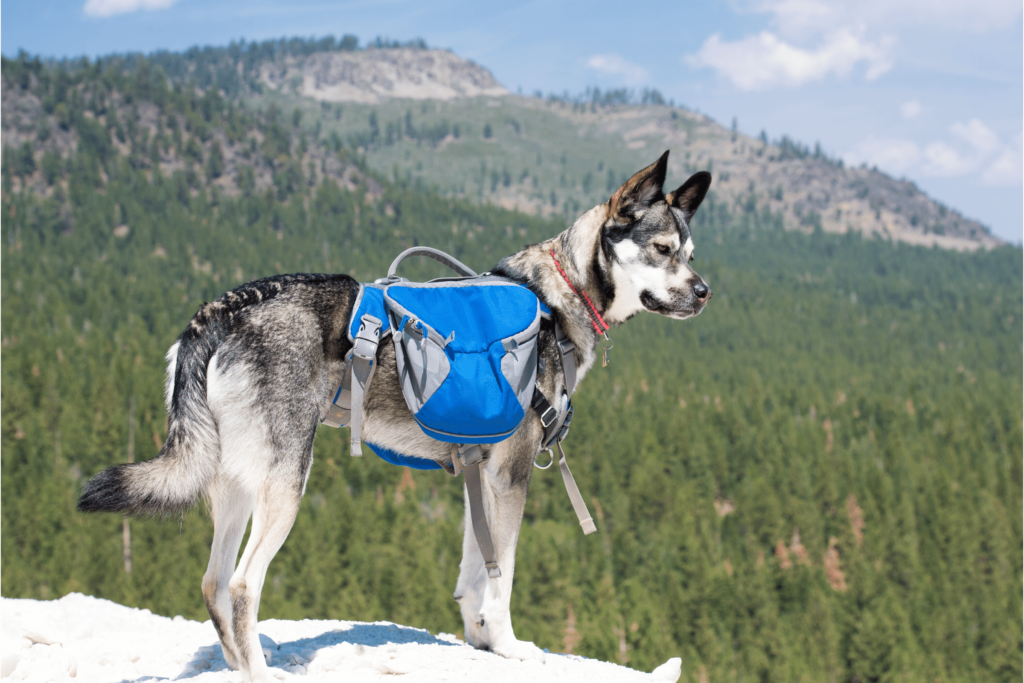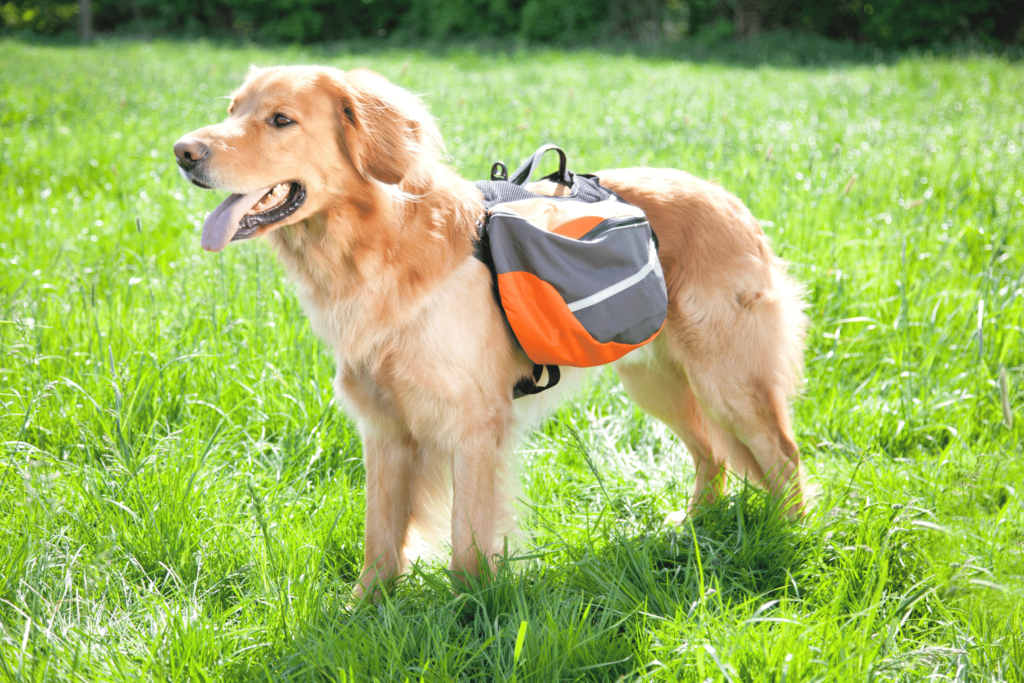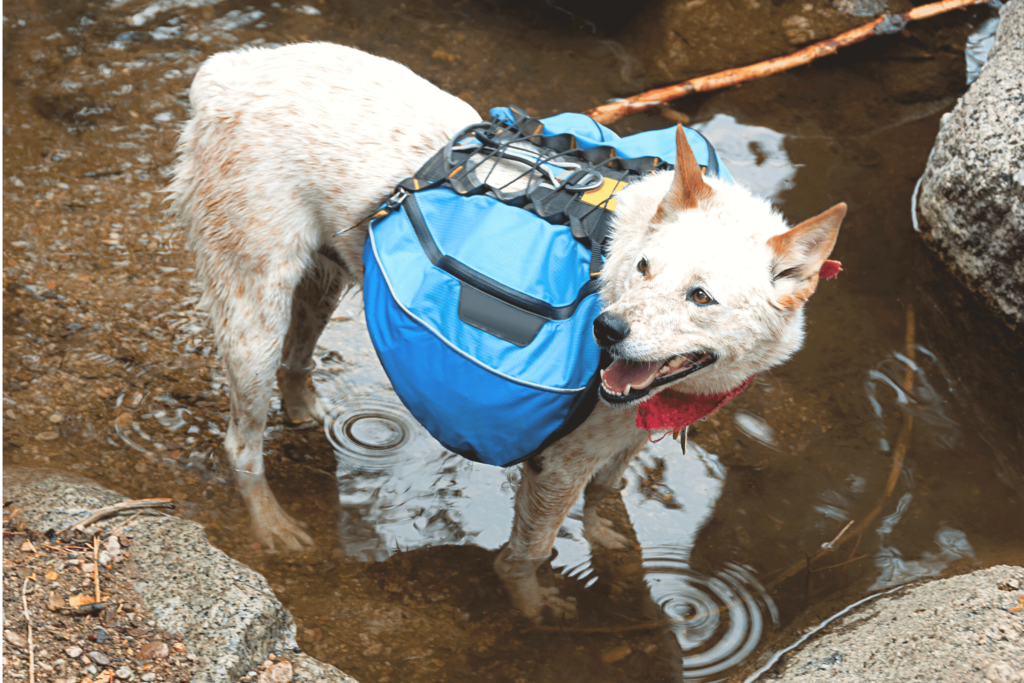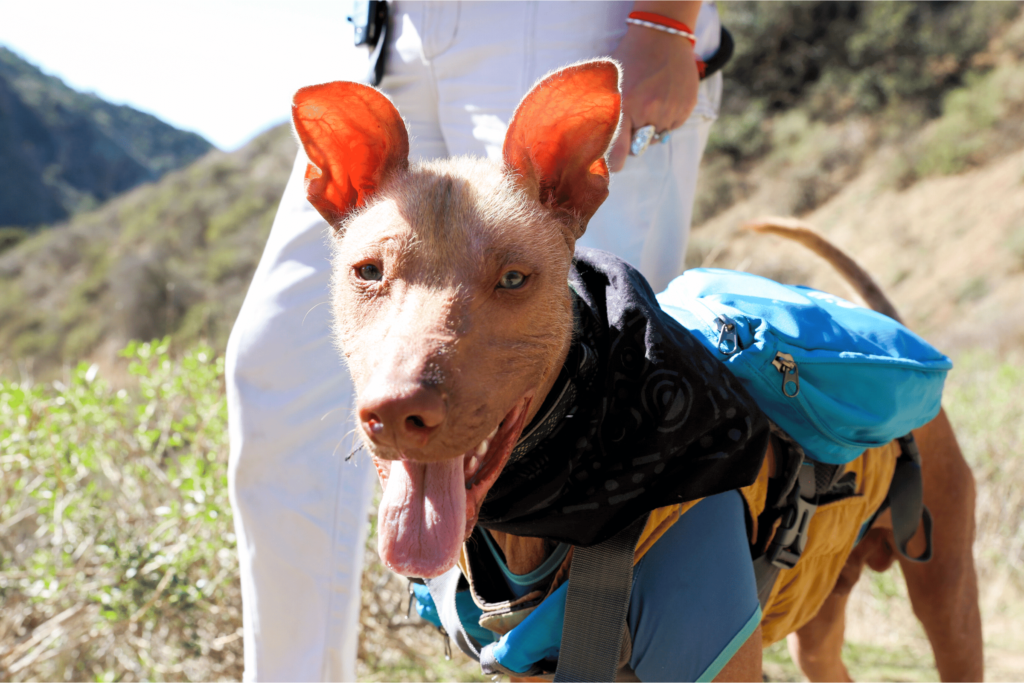Backpacks for dogs have grown in popularity over the last few years. They’re great for hiking and backpacking trips or even just walks around the city to help free up pet parents’ hands. But are dog backpacks safe for your pup?

In this article, you’ll learn the pros and cons of dog backpacks, popular dog backpack makers, how to find the right fit for your pup, and more! Let’s jump right in.
Pros of a Dog Wearing a Backpack
There are several benefits to a dog carrying its own pack! If used properly, dog backpacks can:
- Free up pet parents’ hands by carrying your or your dog’s belongings
- Intensify the level of your dog’s exercise by adding a bit of weight to his or her frame
- Provide easy access to dog accessories and gear like poop bags and collapsible water bowls
- Create space in your own pack by having your dog carry some of his or her own gear
- Help your dog focus on the trail ahead instead of on distractions like squirrels and cats
- Give your dog a job so he or she feels a sense of purpose

Cons of a Dog Wearing a Backpack
As with most benefits, there are usually some related downsides, even when precautions are taken. Before outfitting your dog with a backpack, know that they may:
- Increase pressure on your dog’s joints
- Incorrectly fit to your dog, causing irritation
- Lead to lack of balance if not loaded or sized correctly
- Cause spine curvature from too much weight being carried
- Overheat your dog if the pack is not well ventilated
Who Makes Dog Backpacks?
Some of the top reputable brands out there that sell dog gear, including dog backpacks, are listed below. You’ll probably recognize some of these names!
Is there a brand you trust that is not listed here? Let me know so I can check them out!
Are Dog Backpacks Safe for Dogs?
I’ll get straight to the point here. When utilized correctly, your dog can safely wear a backpack, but it’s always good to check with your vet since he or she knows your dog’s background. Note that the above-listed pros of dog backpacks are in place when packs are used properly.
Do Dog Backpacks Hurt Dogs?
If you review the cons of dog backpacks listed above, you’ll see there are some cases when dog backpacks may injure your dog. That’s why sizing and fit are so important, as well as how you pack your dog’s backpack and with how much weight.
I have listed some instances below in which dogs should not wear backpacks. Keep these warnings in mind before purchasing a pack for your dog.

When are Dog Backpacks Bad for Dogs
Puppies – Your dog should be fully grown before wearing a packed backpack. Though puppies are considered adult dogs at 12 months of age, their bones and joints are still developing. And the added weight of carrying a backpack is not good for their joints.
Puppies are typically fully grown at around 18 months old, so to be safe, give your puppy time to mature and fully finish growing before outfitting them with a backpack.
Senior Dogs – Many senior dogs develop arthritis later in life, especially if they are overweight. Symptoms of arthritis in dogs can include lameness, stiffness, or limping; inactivity or sleeping more; and a reluctance to walk, run or climb stairs.
Arthritis affects dogs’ joints, which can be quite painful for them. Adding the weight of a backpack and its contents increases pressure on their joints, which should be avoided.
Consider retiring your dog’s backpack when he or she hits senior years (at approximately 8 or 9 years old) or if they develop other concerning health issues.
Dogs with Health Issues – In addition to arthritis, there are other health issues (like cancer, skin conditions, and respiratory problems) that will determine whether your pup should or should not wear a backpack.
Our four-year-old dog was recently diagnosed with Spondylosis (a spine condition more common in senior dogs). We’ve had to make some lifestyle changes for her, which include moderating her activity levels while still keeping her safely active and happy.
One of the decisions we made was to shorten the hikes we take her on and to not have her carry a dog backpack anymore.
We want to do everything we can to limit the pressure on her spine but still take her to enjoy the activities she loves!
How to Choose a Backpack for Your Dog?
Before we get into fit and sizing, there are a few things to consider when shopping for a dog backpack. You’ll want to answer the following questions when comparing products:
- Do the backpack compartments (aka saddlebags) attach with Velcro or are they sewn on? Compartments that are not permanently sewn on can easily be dislodged from your dog’s pack if they run too hard or walk into areas of thick brush.
- Does the pack come with built-in padding? If padding is added, that may be a potential benefit to keep contents from poking into your dog’s back or side.
- Does the backpack offer breathability? If there is no mesh webbing or other features to keep your pup cool while wearing a pack, consider other backpacks instead.
- Is the pack waterproof? If your dog loves to run through, swim, or lay in water during walks and hikes, you’ll want to look into waterproof packs for them instead to help keep their pack contents dry. Otherwise, you can load contents into a dry sack before storing them in your dog’s pack.
- What are the cleaning instructions for the dog backpack? Packs are likely to get dirty even after one use on a hike or backpacking trip. Being able to easily spot-clean or wash the pack is a benefit.

How to Fit Your Dog for a Backpack?
Most online stores have size charts to help you purchase the correct size backpack for your dog. They will likely have you use a soft, flexible measuring tape to measure around the widest part of its chest (aka the “girth”) as well as the widest part of your dog’s neck. Next, you’ll likely want to measure your pup from the base of its neck to the base of its tail to determine its length.
You want the backpack to have a snug fit so it doesn’t slide to one side causing your dog discomfort or losing balance. But if the backpack is too tight it could also hinder lung function – and that’s not good regardless of whether you’re on a short walk or a longer hike. Your dog should also be able to move about normally with the backpack on, with free range of motion in its legs and neck.
Dog backpacks should come with adjustable sizing straps so you can find the perfect fit for your best bud. But those straps shouldn’t be so long that they dangle and annoy or trip your dog.
How Much Weight Can Dogs Carry in Their Backpack?
There are many inconsistent answers to this question out there, which we’ll get into in this section. But here’s what I know. You should let your dog build up to any maximum weight – don’t just max it out right off the bat.

According to the Ruffwear website, it’s best to limit your dog’s carry weight (including the backpack and its contents) to 25% of your dog’s body weight or under. So, if your dog weighs, 75 lbs, the most he or she should carry in its pack is about 18 lbs.
I have personally tried this with my 65-75 lb dogs and it’s clearly been too much added weight for them. They tired out very quickly, even after building up to that weight on hikes.
I instead tend to agree with Cesar’s Way, which suggests filling the pack to weigh no more than 10-12% of your dog’s body weight. So, for a 75 lb dog, that would mean the maximum load it could carry is closer to 9 lbs.
The latter makes more sense to me and is what we stick to for our dogs. But you’ll have to make that call for your pup(s) based on their weight, health, and veterinarian feedback.
How to Prepare Your Dog for Wearing a Dog Pack
Before you head out on a hiking or backpacking adventure with your furry companion, you’ll want to get your pup used to wearing a pack.
Some adventure canines are always ready to take on new environments, gear, and trails without a second thought. But many dogs take a bit longer to cozy up to the idea of something new. Never force the backpack on your dog if he or she seems stressed – take it slow and help them warm up to it.

There are a few simple steps to take that will help condition your dog to wearing the backpack you’ve purchased for them.
- Lay the pack on the floor of the room your dog is in. Each time your pup approaches, sniffs, or touches the pack, reward them with verbal praise and a treat.
- With your dog next to you, slowly and gently touch the pack to his or her paw, leg, or back and immediately follow that up with a treat.
- Once your dog is comfortable being around the new pack, start with a walk around your neighborhood while your pup wears his or her empty pack.
- On your next walk, graduate to a lightly packed backpack with only 3-5% of your dog’s body weight
- Next up, pack your dog’s bag as you would for a longer trip, but only take a quick 1 mile walk or hike.
- When your dog is ready, it’s time for a longer hike or overnight backpacking trip!
Keep a close eye on your dog throughout all the above steps to ensure they’re comfortable and not tiring out too quickly.

Conclusion
So, to those still wondering “are dog backpacks safe?” – yes, they are safe for dogs when used, fit, and packed correctly. It’s a good idea to run the idea by your vet as well for their feedback, since they are familiar with your dog and its background.
After each walk or hike, inspect your pup for any skin irritation. If you do notice chaffing, the pack is either too tight or loaded with too much weight, so you’ll need to adjust.
Which dog backpack are you considering for your dog? Let me know in the comments!
Related Posts
- What is Dog Pet Insurance (and is it Worth the Cost)?
- 8 Best Slow Feed Bowls for Dogs (and Why Our Dogs Use Them)
